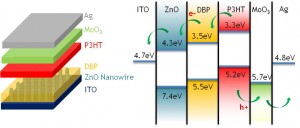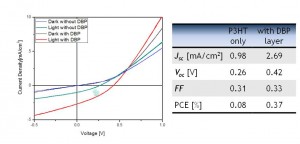ZnO Nanowire Arrays/Conductive Polymer Hybrid Solar Cells with Interfacial layer
- Category: Electronic Devices, Energy, Materials, Nanotechnology
- Tags: sehoon chang, silvija gradecak
Organic/inorganic hybrid solar cells based on the integration of conductive polymers into semiconducting nanowire arrays offer opportunities for the development of hybrid devices with increased power conversion efficiencies due to high charge carrier collection, one-dimensional transport pathways, and large interfacial area [1] [2] . However, control of the nanowire density and effective infiltration of conductive polymers into nano-sized gaps within semiconducting nanowire arrays have been challenging. Here, an inverted device structure of a hybrid solar cell (Figure 1) has been realized by utilizing ZnO nanowire arrays hydrothermally grown directly on an ITO electrode and by using an effective polymer coating. The hydrothermal growth technique enables realization of highly uniform, vertically-aligned ZnO nanowires over large areas on electrode.
The photovoltaic device performance was investigated by controlling the size and density of ZnO nanowires, the thickness of conductive polymer consistent with carrier diffusion lengths, and the organic interfacial layer [3] . The size and density of ZnO nanowires were successfully controlled by the concentration of precursor solution (zinc nitrate hexahydrate, hexamethylenetetramine), growth time, and temperature. Effective infiltration of P3HT was achieved using a vacuum annealing technique which eliminated voids and maximized the interfacial area between ZnO and P3HT. Enhanced P3HT crystallinity was observed through UV-Vis absorption and PL quenching showed effective charge separation in vacuum-annealed samples. Hybrid devices with an interfacial layer, Dibenzo{[f,f′]-4,4′,7,7′-tetraphenyl}diindeno[1,2,3-cd:1′,2′,3′-lm]perylene (DBP), exhibit increased short circuit current (Jsc) and open circuit voltage (Voc) (Figure 2). The DBP interfacial layer provides cascade charge transfer from P3HT to ZnO nanowires. The highest power conversion efficiency (PCE) has been demonstrated using only ZnO nanowire arrays/organic electron donor materials without any inorganic buffer layer such as TiO2 or dye modification of ZnO nanowires. The scalable, cost-effective approach to synthesize ZnO nanowire arrays and the effective coating of organic electron donor materials over the arrays are promising for applications in hybrid solar cells device fabrication.
- Figure 1: Device structure (left) and energy band diagram (right) of ZnO nanowire/P3HT hybrid device with DBP interfacial layer.
- Figure 2: J-V characteristic of ZnO nanowire/P3HT hybrid device with DBP interfacial layer.
- S. Ren, N. Zhao, S. C. Crawford, M. Tambe, V. Bulovic, and S. Gradečak, “Heterojunction photovoltaics using GaAs nanowires and conjugated polymers,” Nano Letters, vol. 11, pp. 408–413, Feb. 2011. [↩]
- S. Ren, L.-Y. Chang, S. K. Lim, J. Zhao, M. Smith, N. Zhao, V. Bulovic, M. Bawendi, and S. Gradečak, “Inorganic-organic hybrid solar cell: Bridging quantum dots to conjugated polymer nanowires,” Nano Letters, vol. 11, pp. 3998–4002, Aug. 2011. [↩]
- B. Kannan, K. Castelino, and A. Majumdar, “Design of nanostructured heterojunction polymer photovoltaic devices,” Nano Letters, vol. 3, pp. 1729–1733, Nov. 2003. [↩]

